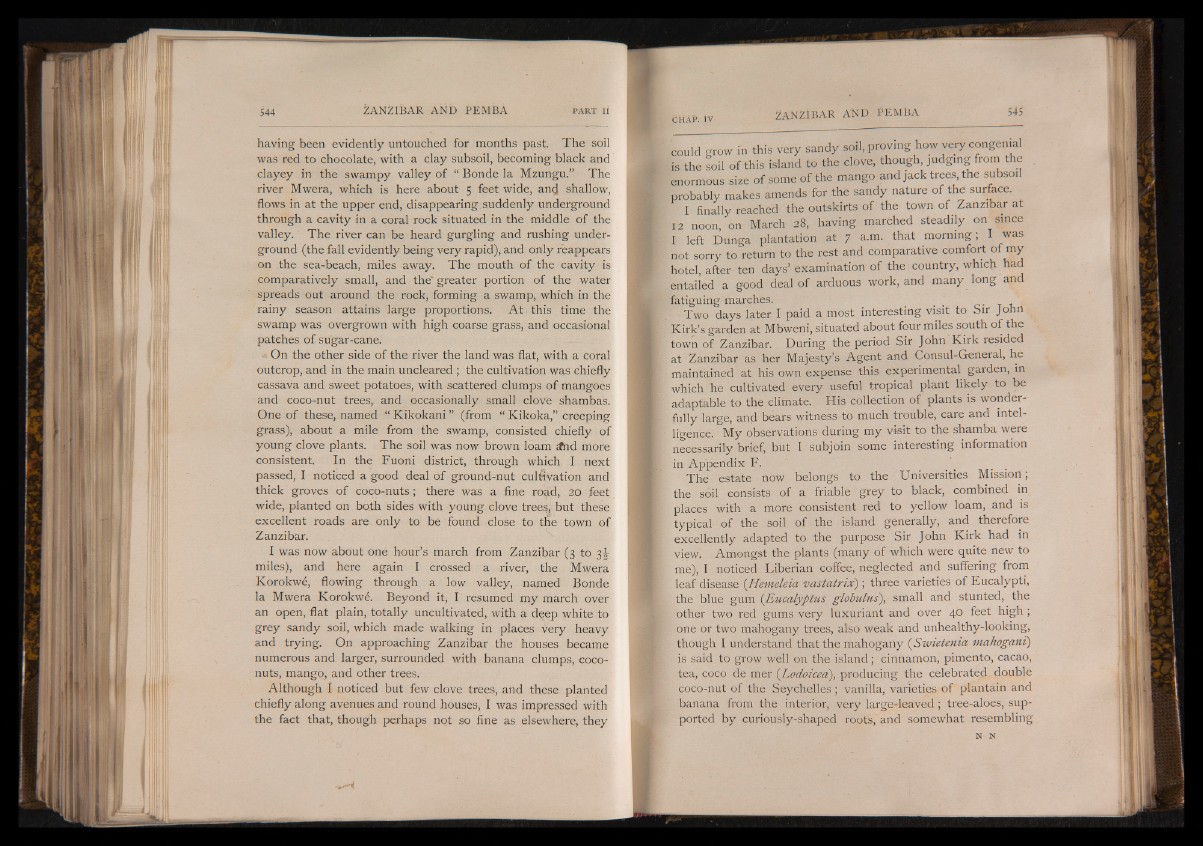
having been evidently untouched for months past. The soil
was red to chocolate, with a clay subsoil, becoming black and
clayey in the swampy valley of “ Bonde la Mzungu.” The
river Mwera, which is here about 5 feet wide, and shallow,
flows in at the upper end, disappearing suddenly underground
through a cavity in a coral rock situated in the middle of the
valley. The river can be heard gurgling and rushing underground
(the fall evidently being very rapid), and only reappears
on the sea-beach, miles away. The mouth of the cavity is
comparatively small, and the' greater portion of the water
spreads out around the rock, forming a swamp, which in the
rainy season attains large proportions. At -this time the
swamp was overgrown with high coarse grass, and occasional
patches of sugar-cane.
* On the other side of the river the land was flat, with a coral
outcrop, and in the main uncleared ; the cultivation was chiefly
cassava and sweet potatoes, with scattered clumps of mangoes
and coco-nut trees, and occasionally small clove shambas.
One of these, named “ Kikokani I (from “ Kikoka,” creeping
grass), about a mile from the swamp, consisted chiefly of
young clove plants. The soil was now brown loam Efnd more
consistent. In the Fuoni district, through which I next
passed, I noticed a good deal of ground-nut cultivation and
thick groves of coco-nuts; there was a fine road, 20 feet
wide, planted on both sides with young clove tree% but these
excellent roads are only to be found close to thie town of
Zanzibar.
I was now about one hour’s march from Zanzibar (3 to 3|
miles), and here again I crossed a river, the Mwera
Korokw6, flowing through a low valley, named Bonde
la Mwera Korokw6. Beyond it, I resumed my march over
an open, flat plain, totally uncultivated, with a deep white to
grey sandy soil, which made walking in places very heavy
and trying. On approaching Zanzibar the houses became
numerous and larger, surrounded with banana clumps, coconuts,
mango, and other trees.
Although I noticed but few clove trees, and these planted
chiefly along avenues and round houses, I was impressed with
the fact that, though perhaps not so fine as elsewhere, they
could grow in this very sandy s o i l , proving how very congenial
is the soil of this island to the clove, though judging from the
enormous size of some of the mango and jack trees, the subsoil
probably makes amends for the sandy nature of the surface.
I finally reached the outskirts of the town of Zanzibar at
12 noon, on March 28, having marched steadily on since
I left Dunga plantation at 7 a.m. that morning; I was
not sorry to return to the rest and comparative comfort of my
hotel, after ten days’ examination of the country, which had
entailed a good deal of arduous work, and many long and
fatiguing marches. _ • t
Two days later I paid a most interesting visit to Sir John
Kirk’s garden at Mbweni, situated about four miles south of the
town of Zanzibar. During the period Sir John Kirk resided
at Zanzibar as her Majesty’s Agent and Consul-General, he
maintained at his own expense this experimental garden, in
which he cultivated every useful tropical plant likely to be
adaptable to the climate. His collection of plants is wonderfully
large, and bears witness to much trouble, care and intel-
ligcnce. My observations during my visit to the shamba were
necessarily brief, but I subjoin some interesting information
Un Appendix F.
The estate now belongs to the Universities Mission;
the soil consists of a friable grey to black, combined in
places with a more consistent red to yellow loam, and is
typical of the soil of the island generally, and therefore
excellently adapted to the purpose Sir John Kirk had in
view. Amongst the plants (many of which were quite new to
me), I noticed Liberian coffee, neglected and suffering from
leaf disease (Hemeleia vastatrix) ; three varieties of Eucalypti,
the blue gum (Eucalyptus globulus), small and stunted, the
other two red gums very luxuriant and over 40 feet high;
one or two mahogany trees, also weak and unhealthy-looking,
though I understand that the mahogany (Swietenia mahogani)
is said to grow well on the island; cinnamon, pimento, cacao,
tea, coco de mer (JLodoicea), producing the celebrated double
coco-nut of the Seychelles ; vanilla, varieties of plantain and
banana from the interior, very large-leaved; tree-aloes, supported
by curiously-shaped roots, and somewhat resembling
N N